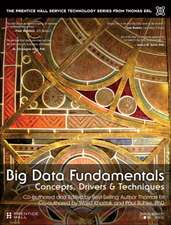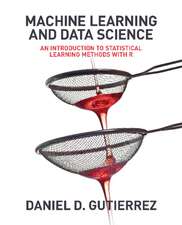A Course in In-Memory Data Management: The Inner Mechanics of In-Memory Databases
Autor Hasso Plattneren Limba Engleză Paperback – 15 mai 2015
This book is based on the first online course on the openHPI e-learning platform, which was launched in autumn 2012 with more than 13,000 learners. The book is designed for students of computer science, software engineering, and IT related subjects. However, it addresses business experts, decision makers, software developers, technology experts, and IT analysts alike. Plattner and his group focus on exploring the inner mechanics of a column-oriented dictionary-encoded in-memory database. Covered topics include - amongst others - physical data storage and access, basic database operators, compression mechanisms, and parallel join algorithms. Beyond that, implications for future enterprise applications and their development are discussed. Readers are lead to understand the radical differences and advantages of the new technology over traditional row-oriented disk-based databases.
| Toate formatele și edițiile | Preț | Express |
|---|---|---|
| Paperback (2) | 579.66 lei 43-57 zile | |
| Springer Berlin, Heidelberg – 15 mai 2015 | 579.66 lei 43-57 zile | |
| Springer Berlin, Heidelberg – 17 sep 2016 | 580.31 lei 43-57 zile | |
| Hardback (1) | 569.50 lei 17-23 zile | +50.18 lei 6-12 zile |
| Springer Berlin, Heidelberg – 11 iun 2014 | 569.50 lei 17-23 zile | +50.18 lei 6-12 zile |
Preț: 579.66 lei
Preț vechi: 681.95 lei
-15% Nou
Puncte Express: 869
Preț estimativ în valută:
110.93€ • 115.39$ • 91.58£
110.93€ • 115.39$ • 91.58£
Carte tipărită la comandă
Livrare economică 14-28 aprilie
Preluare comenzi: 021 569.72.76
Specificații
ISBN-13: 9783642443145
ISBN-10: 3642443141
Pagini: 324
Ilustrații: XXIII, 297 p.
Dimensiuni: 155 x 235 x 17 mm
Greutate: 0.45 kg
Ediția:2013
Editura: Springer Berlin, Heidelberg
Colecția Springer
Locul publicării:Berlin, Heidelberg, Germany
ISBN-10: 3642443141
Pagini: 324
Ilustrații: XXIII, 297 p.
Dimensiuni: 155 x 235 x 17 mm
Greutate: 0.45 kg
Ediția:2013
Editura: Springer Berlin, Heidelberg
Colecția Springer
Locul publicării:Berlin, Heidelberg, Germany
Cuprins
Introduction.- The Future of Enterprise Computing: New Requirements for Enterprise Computing.- Enterprise Application Characteristics.- Changes in Hardware.- A Blueprint of SanssouciDB.- Foundations of Database Storage Techniques: Dictionary Encoding.- Compression.- Data Layout in Main Memory.- Partitioning.- In-Memory Database Operators: Delete.- Insert.- Update.- Tuple Reconstruction.- Scan Performance.- Select.- Materialization Strategies.- Parallel Data Processing.- Indices.- Join.- Aggregate Functions.- Parallel Select.- Workload Management and Scheduling.- Parallel Join.- Parallel Aggregation.- Advanced Database Storage Techniques: Differential Buffer.- Insert- Only.- The Merge Process.- Logging.- Recovery.- On-the-fly Database Reorganization.- Foundations for a New Enterprise Application Development Era: Implications on Application Development.- Database Views.- Handling Business Objects.- Bypass Solution.- Self Test Solution.
Notă biografică
Prof. Dr. h.c. Hasso Plattner is the chair of the "Enterprise Platform and Integration Concepts" research group at HPI, which focuses mainly on In-Memory Data Management for Enterprise Applications. He is author and co-author of over 50 scientific publications and has served conferences such as ACM SIGMOD as a keynote speaker. He is author of "In-Memory Data Management" and currently serves as a visiting professor at the Stanford University Institute of Design. Hasso Plattner is also a co-founder of SAP AG, where he served as CEO until 2003 and has since been chairman of the supervisory board. SAP AG today is the leading provider of enterprise software solutions. In his role as chief software advisor, he concentrates on defining the mid- and long-term technology strategy and direction of SAP.
Textul de pe ultima copertă
Recent achievements in hardware and software development, such as multi-core CPUs and DRAM capacities of multiple terabytes per server, enabled the introduction of a revolutionary technology: in-memory data management. This technology supports the flexible and extremely fast analysis of massive amounts of enterprise data. Professor Hasso Plattner and his research group at the Hasso Plattner Institute in Potsdam, Germany, have been investigating and teaching the corresponding concepts and their adoption in the software industry for years.
This book is based on the first online course on the openHPI e-learning platform, which was launched in autumn 2012 with more than 13,000 learners. The book is designed for students of computer science, software engineering, and IT related subjects. However, it addresses business experts, decision makers, software developers, technology experts, and IT analysts alike. Plattner and his group focus on exploring the inner mechanics of a column-oriented dictionary-encoded in-memory database. Covered topics include - amongst others - physical data storage and access, basic database operators, compression mechanisms, and parallel join algorithms. Beyond that, implications for future enterprise applications and their development are discussed. Readers are lead to understand the radical differences and advantages of the new technology over traditional row-oriented disk-based databases.
This book is based on the first online course on the openHPI e-learning platform, which was launched in autumn 2012 with more than 13,000 learners. The book is designed for students of computer science, software engineering, and IT related subjects. However, it addresses business experts, decision makers, software developers, technology experts, and IT analysts alike. Plattner and his group focus on exploring the inner mechanics of a column-oriented dictionary-encoded in-memory database. Covered topics include - amongst others - physical data storage and access, basic database operators, compression mechanisms, and parallel join algorithms. Beyond that, implications for future enterprise applications and their development are discussed. Readers are lead to understand the radical differences and advantages of the new technology over traditional row-oriented disk-based databases.
Caracteristici
Presents the inner mechanics of an in-memory database Includes 34 learning units with more than 100 self-tests and comprehensive explanation Explains a major new develoment in enterprise computing Includes supplementary material: sn.pub/extras















